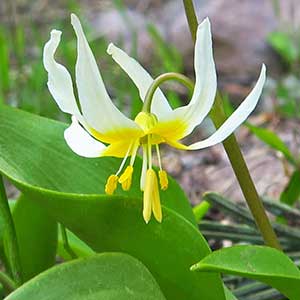Erythronium klamathense
Erythronium mesochoreum
Klamath fawn-lily
midland fawnlily, prairie trout-lily, white fawnlily
slender, 25–40 mm.
ovoid to ± globose, 10–25 mm;
stolons absent; flowering plants reproducing vegetatively by droppers or offshoots.
6–17 cm;
blade green, lanceolate to narrowly elliptic, ± folded along midvein, margins entire to wavy.
5–14 cm;
blade green, usually not mottled, elliptic-lanceolate to ovate-lanceolate, conduplicate, glaucous, base and margins sometimes purple-brown, margins even.
6–20 cm.
5–15 cm.
1–3-flowered.
1-flowered.
tepals 2/3 or more white, with yellow zone at base, ± pinkish in age, broadly lanceolate, 20–35 mm, inner with small auricles at base;
stamens 8–14 mm;
filaments white, slender;
anthers ± yellow;
style white, 4–9 mm;
stigma ± unlobed.
tepals spreading at anthesis, white, tinged pink, blue, or lavender abaxially, with yellow adaxial spot at base, lanceolate, 15–30 mm, auricles absent;
stamens 8–15 mm;
filaments yellow, lanceolate;
anthers yellow;
pollen yellow;
style white, 7–10 mm;
stigma lobes recurving, 1–1.5 mm.
narrowly obovoid, 2–5 cm.
resting on ground at maturity due to reclining peduncle, obovoid, 10–15 mm, apex rounded to faintly apiculate or umbilicate.
= 24.
= 22.
Erythronium klamathense
Erythronium mesochoreum
Because stolons are absent in Erythronium mesochoreum, most plants in a population produce flowers; nonflowering plants may sometimes appear after flowering plants have flowered. This species is well adapted to prairie fires. The seeds have elaiosomes, and ants may act as dispersal agents (Great Plains Flora Association 1986). C. C. Deam et al. (1941) reported E. mesochoreum from Indiana, but an examination of the specimens cited, now at IND, showed that these are E. albidum. E. L. Braun (1967) reported that many populations of E. albidum in southwestern Ohio indicate introgression with “the Ozarkean var. mesochoreum���.” However, personal observation by K. R. Robertson of several Ohio populations in flower confirmed that these plants are true E. albidum, although they occur in prairies and have more or less conduplicate leaves.
(Discussion copyrighted by Flora of North America; reprinted with permission.)


